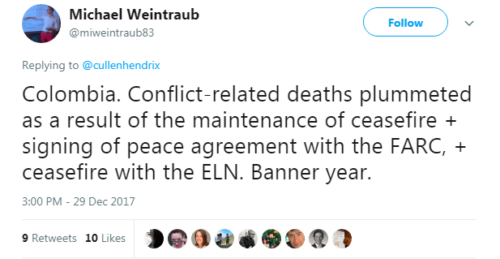By Cullen Hendrix for Denver Dialogues
Conflict scholarship can be a grim work, and 2017 provided bushels of grist for the mill: hunger is up, driven by conflict and climate change, the Syrian conflict grinds on, and smart foreign policy watchers see the United States as on a potential path to war with North Korea. Nationalism is on the rise and the incidence of hate crimes rose for the second straight year in the United States. It’s enough to make one want to stay in bed–if one didn’t already, given yesterday was New Year’s Day.
But the news wasn’t all bad. In an attempt to crowdsource the bright spots and silver linings, I posed the following to Twitter:
The responses (with some editorializing on my part) were great, and highlighted both dynamics in several major conflicts and macro processes:
The Ongoing Colombian Peace Process
Indeed. Prior to late 2016, Colombia had been at war with itself for almost 70 years, first during La Violencia and later during the conflict between various armed groups–the FARC, ELN, and AUC largest among them–and the Colombian government. The conflict had claimed nearly a quarter-million lives. Following a historic peace agreement between the FARC and the Colombian government in September 2016, 2017 saw that tenuous peace mostly hold. Conflict deaths have plummeted and international observers and researchers are monitoring the implementation of the peace process. For more on Colombia’s path toward peace, see excellent earlier posts by Oliver Kaplan.
Improvements in Somalia

Somalia, of course, has been in a state of conflict since 1988; currently, the main conflict pits the Federal Government of Somalia against al-Shabaab, with numerous other non-state conflicts ongoing between clan-based armed groups. The massive (and evidently errant) truck bombing of a Mogadishu market notwithstanding, Somalia watchers noted improving dynamics there: increased FDI and donor engagement, more Somali expats returning, and consolidation of relative peace and governance in Somaliland.
Continuing Reductions in Poverty
As the IMF World Economic Outlook notes, global growth is projected to finish 2017 at 3.6% and rise slightly to 3.7% in 2018. The gains are widespread, too, with upward swings in the Eurozone, Japan, and emerging Asia–the last of which is crucial for continuing the downward trends in extreme poverty seen in the last two decades. Given low GDP per capita is perhaps the single most robust covariate of armed conflict, this bodes well both for human wellbeing and peace and security.
Very little coup activity
Aside from Robert Mugabe’s bloodless ouster (which may or may not be considered a true coup), 2017 saw no coups d’etat, and none against a freely and fairly elected government. Given that one in four countries has had a coup attempt since 1990, this decrease in coup activity–both successful and attempted–is good news, especially for democratically elected governments in fragile states.
So, there were some bright spots in 2017. And surely there are even more. What did I/we miss? And what do you think the bright spots will be in 2018?
Thanks to Michael Weintraub, Bridget Coggins, Yon Lupu, Max Roser via Cy Rogers, and Andreas Beger for their input. Here’s wishing you all a bright 2018.














3 comments
There was a credible election which seems to be leading to a peaceful, democratic transfer of power in Liberia.
Good point!
Thanks for this encouraging piece by the way!